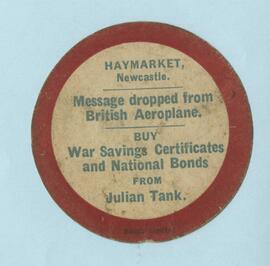CRICK, Dr Alan John Pitts (1913-1995)
- CRICK
- Collection
- 1938-1984
Papers relating to Crick's service in the Western Desert, 1941-1943, as Instructor, War Intelligence Course, School of Military Intelligence, Matlock, Derbyshire, 1943-1944, and with Operational Intelligence, G2 Division, Supreme Headquarters Allied Expeditionary Forces (SHAEF), 1944-1945, including copy of War Diary, General Staff Intelligence Branch, Headquarters 8 Army, 25 Sep-31 Oct 1941; typescript memorandum by Crick 'The possible effect of CROSSBOW on OVERLORD', on how Operation CROSSBOW, (Allied countermeasures against German V-weapons), could influence Operation OVERLORD, (the Allied invasion of occupied Europe), Mar 1944; typescript memorandum by Crick 'The heart of Germany', on the importance of the Ruhr industrial region to Allied strategy, Mar 1944; typescript report by Crick on visit to OKW (Oberkommando der Wehrmacht, the German Armed Forces High Command), Flensburg, Germany, 11 May 1945. Papers relating to Crick's service with the British Joint Services Mission, Washington DC, USA, 1953-1956, including typescript text of lecture by Maj Gen Sir Kenneth William Dobson Strong, Director of Joint Intelligence Bureau, on UK and US Intelligence collaboration and spheres of influence [1953]; typescript memorandum 'Probable Bloc preoccupations in Asia, including Middle East, until mid 1955' [1953]; papers relating to the reorganisation of the Economic and General Division of the Joint Intelligence Bureau, 1956. Papers relating to the Imperial Defence College tour of Pakistan, India, East Pakistan, Ceylon and Aden, Aug-Sep 1960, including itineraries, travel arrangements, three photographs, invitations and a printed map of the Middle East showing oil wells, refineries and pipelines, 1960. Manuscript and typescript notes for a lecture by Crick entitled 'A career in Intelligence', given at Intelligence Corps course, with one audio tape of 20 minute lecture by Crick on interrogation techniques, Ashford College, Kent, Oct 1984. Edition of In the caves of the mind. Poems by Alan Crick (Privately published, Rye, Sussex, 1992). Newspaper cuttings, photographs and publications, 1938-1959, including German newspaper cuttings relating to the visit to Danzig by Rt Hon Alfred Duff Cooper, First Lord of the Admiralty, Aug 1938; three editions of Battledress. The Cadet magazine, Feb-Jun 1940; nine editions of The Crusader Eighth Army Weekly, Oct 1942-Apr 1943; sixteen editions of 'Interim. British Army of the Rhine Intelligence Review', Jun 1945-Apr 1946; three editions of 'Occupation. British Army of the Rhine Intelligence Review', May-Jul 1946. Edition of '21st (British) Army Group in the campaign in North West Europe 1944-1945. Lecture by Field Marshal Sir Bernard L Montgomery to the Royal United Service Institution, London, October 1945'; six photographs and five copies of photographs of Crick, Western Desert and Germany, 1941-1945, and two group photographs, Staff and Students, Joint Services Staff College, 1948, and Military Attachés Conference, Episkopi, Cyprus, 1959.
Crick, Alan John Pitts, 1913-1995, civil servant and historian


